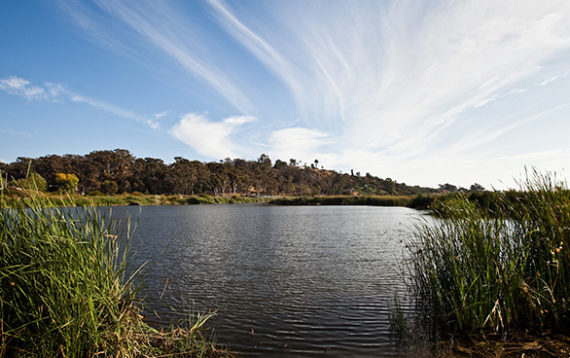Location: San Diego County
Project Type: Restoration Planning
Status: Completed
Habitat Type: tidal wetlands
Date Completed: 2002
Cost: $688,000
Assembly District: 76
Senate District: 36
Congressional District: 49
Project Lead/Grantee:
Buena Vista Lagoon Foundation (Dennis Baker, 949-274-3226)
 For more information, visit scwrp.org
For more information, visit scwrp.org
This project evaluated enhancement options for Buena Vista Lagoon, including the feasibility of establishing tidal flushing within the lagoon.
Buena Vista Lagoon (Lagoon) receives wet and dry weather input from the Buena Vista Creek Watershed. Typical sources of discharges from Buena Vista Creek include stormwater runoff and subsurface runoff under wet weather conditions during storms, and runoff from wastewater, nuisance water, and irrigation return water under dry weather conditions. The inflows carry pollutants in aqueous and particulate phases into the Lagoon. The aqueous phase of a constituent tends to remain in the water column within the Lagoon where it is subject to mixing across the Lagoon and over the water column while undergoing physical, chemical, and biological interactions. The particulate phase of the constituent tends to settle to the Lagoon bottom with the solids it is sorbed to and is possibly redistributed by currents within the Lagoon during high flow or inlet breach events.
Interactions between constituents in the sediment bed and those in the water column can take place across the sediment-water interface. The water quality and sediment quality conditions within the Lagoon need be characterized to determine the potential impact to the beneficial uses of the Lagoon as designated in the San Diego Basin Plan (SDWQCB, 1994), which include the following:
• Contact Water Recreation (fishing from boat or shore)
• Non-Contact Water Recreation
• Biological Habitats of Special Significance
• Wildlife Habitat
• Rare, Threatened, or Endangered Species
• Marine Habitat
• Warm Freshwater Habitat
• Estuarine Habitat (potential)
Evaluation of a full range of constituents in both water column and bottom sediments is needed to identify critical pollutants that are present within the Lagoon at elevated levels that could potentially impact the beneficial uses of the Lagoon. Upon identification of the critical pollutants, the potential source areas within the watershed can be through correlation with land uses.

